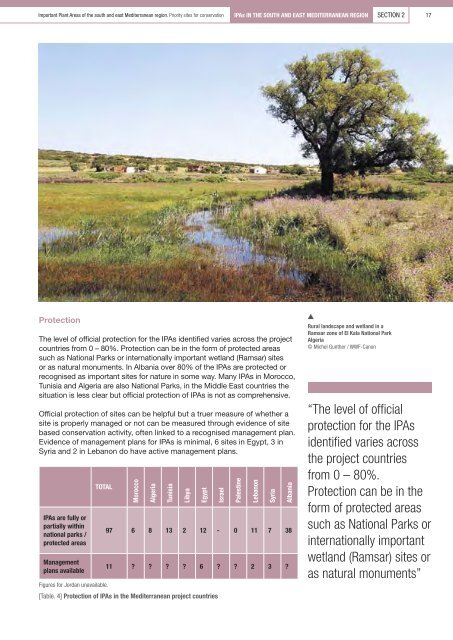Important Plant Areas of the south and east Mediterranean ... - IUCN
Important Plant Areas of the south and east Mediterranean ... - IUCN
Important Plant Areas of the south and east Mediterranean ... - IUCN
You also want an ePaper? Increase the reach of your titles
YUMPU automatically turns print PDFs into web optimized ePapers that Google loves.
<strong>Important</strong> <strong>Plant</strong> <strong>Areas</strong> <strong>of</strong> <strong>the</strong> <strong>south</strong> <strong>and</strong> <strong>east</strong> <strong>Mediterranean</strong> region. Priority sites for conservation<br />
IPAs in <strong>the</strong> <strong>south</strong> <strong>and</strong> <strong>east</strong> <strong>Mediterranean</strong> region<br />
SECTION 2<br />
17<br />
Protection<br />
The level <strong>of</strong> <strong>of</strong>ficial protection for <strong>the</strong> IPAs identified varies across <strong>the</strong> project<br />
countries from 0 – 80%. Protection can be in <strong>the</strong> form <strong>of</strong> protected areas<br />
such as National Parks or internationally important wetl<strong>and</strong> (Ramsar) sites<br />
or as natural monuments. In Albania over 80% <strong>of</strong> <strong>the</strong> IPAs are protected or<br />
recognised as important sites for nature in some way. Many IPAs in Morocco,<br />
Tunisia <strong>and</strong> Algeria are also National Parks, in <strong>the</strong> Middle East countries <strong>the</strong><br />
situation is less clear but <strong>of</strong>ficial protection <strong>of</strong> IPAs is not as comprehensive.<br />
Official protection <strong>of</strong> sites can be helpful but a truer measure <strong>of</strong> whe<strong>the</strong>r a<br />
site is properly managed or not can be measured through evidence <strong>of</strong> site<br />
based conservation activity, <strong>of</strong>ten linked to a recognised management plan.<br />
Evidence <strong>of</strong> management plans for IPAs is minimal, 6 sites in Egypt, 3 in<br />
Syria <strong>and</strong> 2 in Lebanon do have active management plans.<br />
IPAs are fully or<br />
partially within<br />
national parks /<br />
protected areas<br />
Management<br />
plans available<br />
TOTAL<br />
Morocco<br />
Algeria<br />
Tunisia<br />
Libya<br />
Egypt<br />
Israel<br />
Palestine<br />
Lebanon<br />
Syria<br />
97 6 8 13 2 12 - 0 11 7 38<br />
11 6 2 3 <br />
Figures for Jordan unavailable.<br />
[Table. 4] Protection <strong>of</strong> IPAs in <strong>the</strong> <strong>Mediterranean</strong> project countries<br />
Albania<br />
Rural l<strong>and</strong>scape <strong>and</strong> wetl<strong>and</strong> in a<br />
Ramsar zone <strong>of</strong> El Kala National Park<br />
Algeria<br />
© Michel Gun<strong>the</strong>r / WWF-Canon<br />
“The level <strong>of</strong> <strong>of</strong>ficial<br />
protection for <strong>the</strong> IPAs<br />
identified varies across<br />
<strong>the</strong> project countries<br />
from 0 – 80%.<br />
Protection can be in <strong>the</strong><br />
form <strong>of</strong> protected areas<br />
such as National Parks or<br />
internationally important<br />
wetl<strong>and</strong> (Ramsar) sites or<br />
as natural monuments”

















